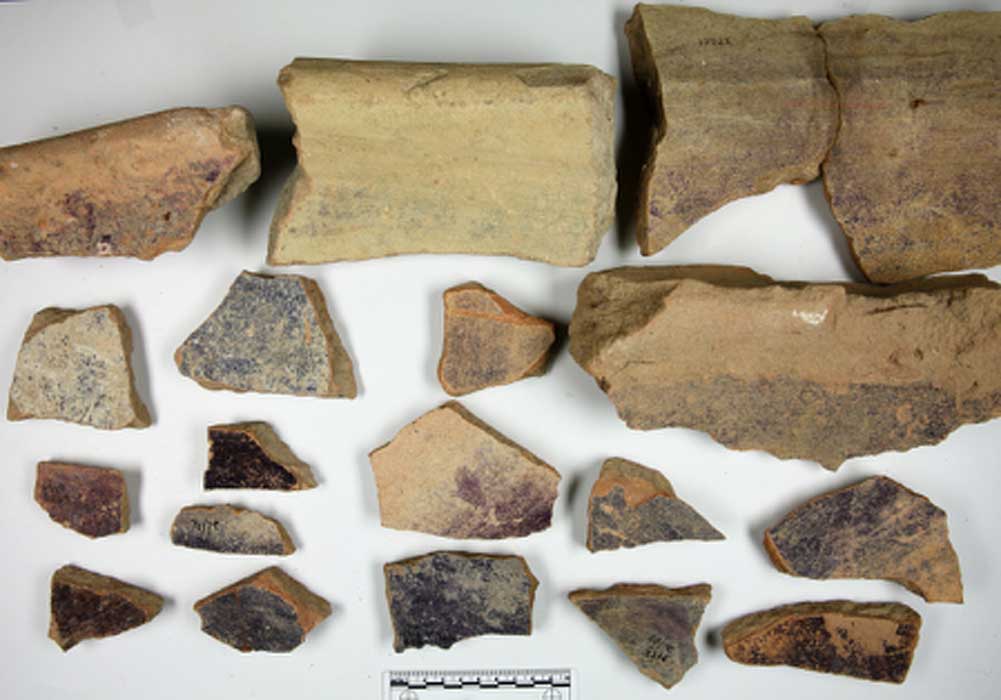3,000-Year-Old Phoenician Shell-Dye Factory Linked With The Temple
Shards of Phoenician pottery excavated fifty years ago from an archeological dig in Tel Shikmona located south of Haifa, in Israel, have revealed that this mysterious Biblical-era stronghold was actually a Phoenician shell-dye factory, and might have manufactured items for the Temple.
Dating back to the Iron Age (11th to 6th century BC) and located in a rocky inaccessible section of the shoreline of the Carmel Coast, the true nature of this site had always baffled archaeologists until Prof. Ayelet Gilboa and Ph.D. candidate Golan Shalvi of the University of Haifa offered a solution which finally explains this mystery.
The Discovery of the Shell-Dye Factory
The Shikmona project was run under the auspices of the Zinman Institute of Archeology at the University of Haifa, with the support of the Israel Antiquities Authority and the National Maritime Museum in Haifa. According to an article published in Breaking Israel News the project “focused on analyzing remnants of blue dye left on 30 shards,” which in turn determined that the blue dye was from the murex snail.
Because the site also contained manufacturing tools and devices for working with textiles, such as looms and spindles, according to Golan Shalvi, “What we found was a [shell-dye] factory for producing dye from the murex snail,” and “that the protected waters adjacent to Tel Shikmona were an ideal habitation for the snails”. It is now understood that the site was operational as a textile factory in the 11th century BC and continued to operate until the 6th century BC which means it was functional throughout the ‘Period of the Judges’ and the ‘Period of the Kingdoms’ of Judea and Samaria.

The shell-dye factory site that produced the blue dye, also contained manufacturing tools and devices for working with textiles. (Maya Margit / YouTube Screenshot)
Researchers use the term argamon to refer to all of the dyes made from snails and this term was also used in the Bible to refer to a particular dye used in the creation of holy items within the Temple. “It is possible to produce a dye of a similar shade from plants, but our analysis proved that this dye was made from snails. This was higher quality, much more expensive, and as a result, lasted much longer,” said Shalvi.
A Scientific Discovery With Veiled Biblical Implications?
A line of thinking which might have Biblical repercussions is that ‘techelet’ was a valuable blue dye in ancient Mediterranean civilizations and was mentioned no less than 49 times in the Hebrew Bible. Among its applications was dying the robes of High Priests and within ‘tzitzit’, which Chabad.org describes as ‘fringes’, and refers to the strings attached to the corners of the tallit, the Jewish prayer shawl. It also refers to the poncho-like mini-tallit that is worn throughout the day, often under a shirt.
- Han Purple: A 2,800-year-old artificial pigment that quantum physicists are trying to understand
- Pottery Reveals America's First Social Media
- Only the Roman Elite Could Wear Tyrian Purple to Keep the Peasants in Their Place

Tzitzit, four tassels or ‘fringes’ with blue threads, produced at the ancient shell-dye factory. (Lkitrossky / Public Domain)
A Haaretz article explains that the traditional Hebrew practice of dying one thread in the tzitzit was abandoned after the destruction of the temple and that “knowledge of how to produce the dye was lost” but many followers of Judaism claim the dye was manufactured from the murex snail. However, to these ideas, Shalvi says “It is currently impossible to determine precisely what techelet was, not for research purposes and not for religious purposes”.
Less skeptical is Rabbi Tuly Weisz, head of Israel365, who firmly believes these archaeological discoveries have “powerful implications for the Redemption” and he cited the Biblical verse: “Thus said the lord of Hosts: In those days, ten men from nations of every tongue will take hold—they will take hold of every Yehudi by a corner of his cloak and say, “Let us go with you, for we have heard that Hashem is with you”.” Zechariah 8:23.
Rabbi Weisz believes the meaning of the prophecy told in Zechariah “was hidden, actually indecipherable” but he added, “As the lost secrets of the tzitzit are revealed, so is the deeper meaning of this verse referring to the fringes of our garments” and this discovery, claims the Rabbi, “portends a greater fulfilling of this prophecy”.

The Bible verse refers to the fringe that was dyed with the holy-dye made at the shell-dye factory. (Hautala / CC BY-SA 3.0)
Though the researchers could not confirm any definitive connections between the techelet factory at Tel Shikmona and the temple, they remain open to such ideas and suggested such connections were “quite possible”.
Why Is This Shell-Dye Factory Important In Scientific Terms?
The rarity of this discovery comes when we consider this is the only site ever discovered in Iron Age Phoenicia that produced the argaman dye, and while other production sites are known of in Lebanon, most of them are from the Classical periods and none of them have provided any direct evidence of manufacture of the holy-dye.
According to the team of scientists the “Carmel Coast can now gain its rightful place as one of the most important production areas of the dye in ancient times in general, and during the Biblical period in particular” and it might just have been the source of dye for the Temple.
Top image: Phoenician pottery shows evidence of shell-dye factory producing Biblical dye. Source: University of Haifa / Fair Use.
By Ashley Cowie



















